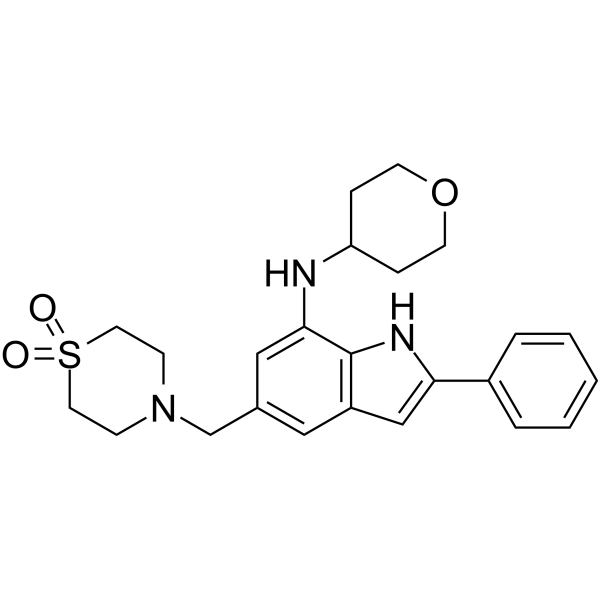NecroX-7
Modify Date: 2024-01-13 20:21:37

NecroX-7 structure
|
Common Name | NecroX-7 | ||
|---|---|---|---|---|
| CAS Number | 1120332-55-9 | Molecular Weight | 439.57 | |
| Density | N/A | Boiling Point | N/A | |
| Molecular Formula | C24H29N3O3S | Melting Point | N/A | |
| MSDS | N/A | Flash Point | N/A | |
Use of NecroX-7NecroX-7 is a potent free radical scavenger and a HMGB1 (high-mobility group box 1) inhibitor. NecroX-7 can be used as an antidote to acetaminophen toxicity. NecroX-7 exerts a protective effect by preventing the release of HMGB1 in ischemia/reperfusion injury. NecroX-7 inhibits the HMGB1-induced release of TNF and IL-6, as well as the expression of TLR-4 and receptor for advanced glycation end products. NecroX-7 can be used graft-versus-host disease (GVHD) research[1]. |
| Name | NecroX-7 |
|---|
| Description | NecroX-7 is a potent free radical scavenger and a HMGB1 (high-mobility group box 1) inhibitor. NecroX-7 can be used as an antidote to acetaminophen toxicity. NecroX-7 exerts a protective effect by preventing the release of HMGB1 in ischemia/reperfusion injury. NecroX-7 inhibits the HMGB1-induced release of TNF and IL-6, as well as the expression of TLR-4 and receptor for advanced glycation end products. NecroX-7 can be used graft-versus-host disease (GVHD) research[1]. |
|---|---|
| Related Catalog | |
| Target |
IL-6 TLR4 |
| In Vitro | NecroX-7 (0-40 μM, 3-4 d) suppresses activated or proliferating T cells without causing apoptosis[1]. NecroX-7 (0-40 μM) markedly reduces HMGB1 levels in a dose-dependent manner[1]. NecroX-7 inhibits formation of mitochondria-specific ROS/reactive nitrogen species in H9C2 cells and hepatocytes after induction by tert-butyl hydroperoxide or doxorubicin[1]. NecroX-7 increased regulatory T cell numbers, which may be associated with regulation of differentiation signals independent of HMGB1[1]. Cell Proliferation Assay[1] Cell Line: CD4 T cells Concentration: 0, 0.625, 1.25, 2.5, 5, 10, 20, and 40 μM Incubation Time: 3-4 d Result: Showed a marked reduction in splenocyte proliferation, in a dose-dependent manner. Modulated alloreactive T cell responses. |
| In Vivo | NecroX-7 (0-0.3 mg/kg, IV, once injection at 2-d intervals, for 2 weeks) significantly attenuates GVHD-related mortality and inhibits severe tissue damage[1]. NecroX-7 protects mice against lethal GVHD by reciprocal regulation of regulatory T/Th1 cells, attenuating systemic HMGB1 accumulation and inhibiting HMGB1-mediated inflammatory response[1]. Animal Model: Female BALB/c and C57BL/6 mice (Eight-week-old, with GVHD)[1] Dosage: 0.03, 0.1, and 0.3 mg/kg Administration: IV, once injection at 2-d intervals, for 2 weeks Result: Observed statistically significant prolonged survival at doses ≥0.1 mg/kg: 30–60% of mice in these treatment groups survived for >50 d. Significantly improved clinical signs and prolonged survival, and the mice showed a reduction in clinical manifestations of acute GVHD, including weight loss, hunched posture, diarrhea, and ruffled fur. |
| References |
| Molecular Formula | C24H29N3O3S |
|---|---|
| Molecular Weight | 439.57 |